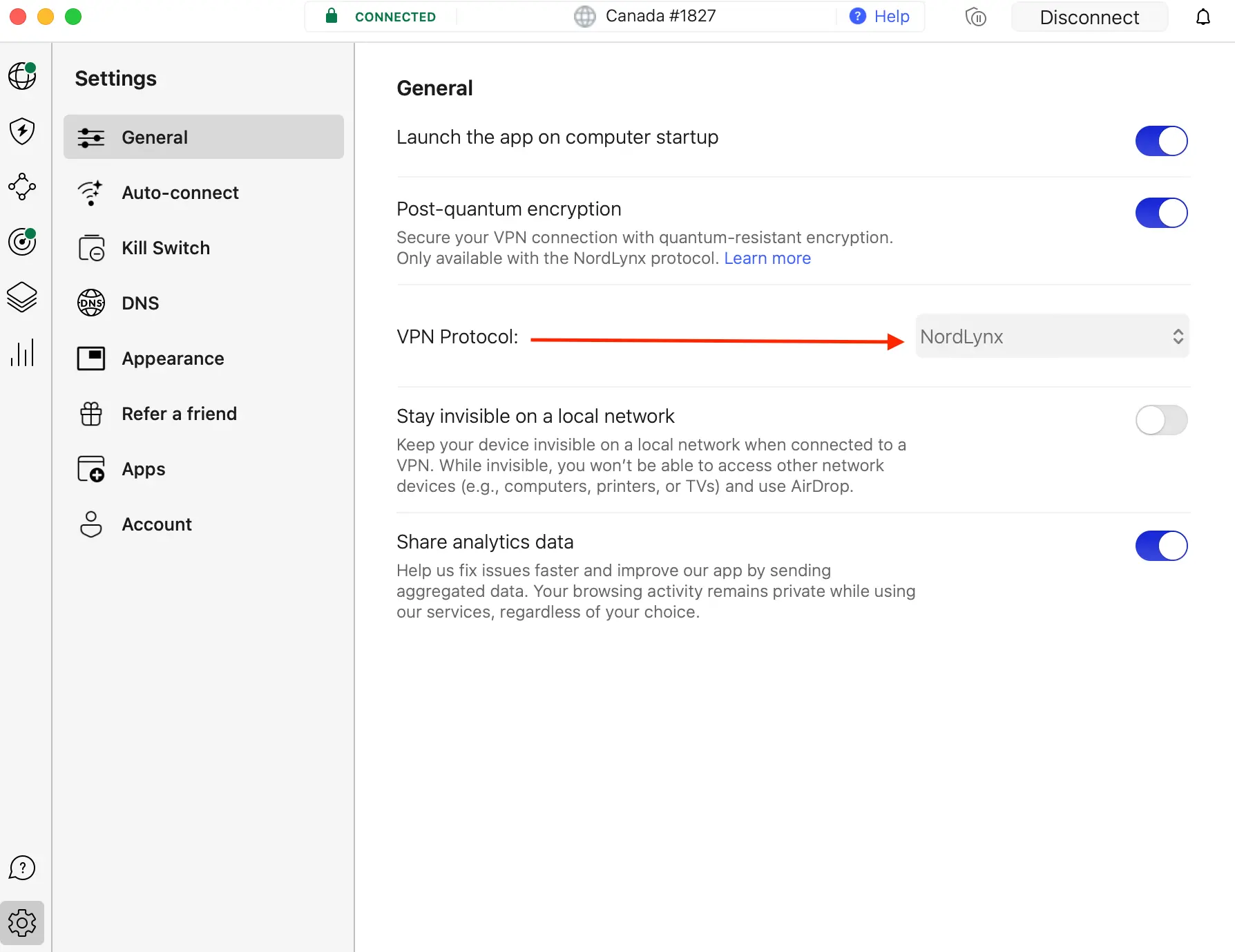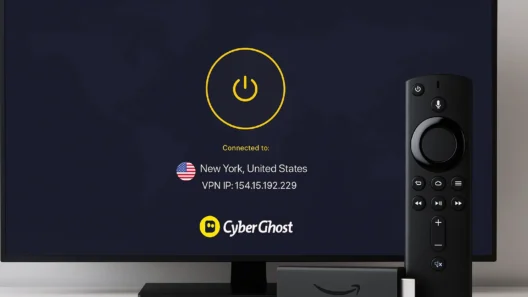As someone who’s used VPNs for over a decade — from legacy protocols like PPTP to more robust ones like IKEv2 — I was naturally skeptical when I first heard about NordLynx. Another so-called “game-changer” in the VPN space? I’ve seen dozens come and go.
But after NordVPN began pushing NordLynx as its default, promising unparalleled speed and privacy, I decided to dig in and conduct my own full-spectrum testing over several weeks across platforms. The results were eye-opening — not just in raw speed, but in real-world usability, encryption strength, latency behavior, CPU usage, and privacy mechanics.
What is NordLynx, Really? Behind the Buzzword

Let’s set the record straight. NordLynx is not a standalone protocol. It’s a custom implementation of WireGuard, wrapped with NordVPN’s own security enhancements — most notably, a double NAT (Network Address Translation)system that fixes WireGuard’s original privacy flaw.
The Privacy Gap in WireGuard
WireGuard, in its raw form, stores static IP addresses on the VPN server. This is fine for enterprise networking — but it’s a no-go for user anonymity. NordVPN’s Double NAT setup dynamically assigns IPs without logging real ones, thus solving the core privacy challenge.
Architectural Differences: Minimalism vs Legacy
Let’s break down why NordLynx is fundamentally different from OpenVPN in its core DNA.
Codebase Complexity
| Protocol | Lines of Code | Age | Built for |
|---|---|---|---|
| OpenVPN | ~70,000+ | Since 2001 | Versatility |
| WireGuard | ~4,000 | Since 2016 | Simplicity |
OpenVPN evolved organically, adding features and patches to maintain compatibility across OSes and networks. This resulted in a bloated but robust framework.
WireGuard — and by extension, NordLynx — was designed clean and from scratch. That small codebase isn’t just for show — it directly translates to less overhead, faster performance, and easier security auditing.
Encryption & Cryptography: Modern vs Mature
NordLynx leverages cutting-edge cryptographic standards:
| Function | Algorithm Used in NordLynx | OpenVPN Equivalent |
|---|---|---|
| Encryption | ChaCha20 | AES-256-CBC |
| Authentication | Poly1305 | SHA256 |
| Key Exchange | Curve25519 | RSA or DH |
| Hashing | BLAKE2s | SHA256 or SHA512 |
ChaCha20 performs better on modern devices, especially those without AES-NI hardware acceleration, such as smartphones or entry-level laptops.
Speed Test: My Multi-Platform Results (Windows, macOS, Android)
I ran dozens of speed tests using NordVPN’s app across different platforms and times of day. Here’s the average outcome:
| Metric | NordLynx | OpenVPN |
|---|---|---|
| Download Speed (avg) | 305 Mbps | 92 Mbps |
| Upload Speed (avg) | 275 Mbps | 85 Mbps |
| Ping / Latency | 11 ms | 36 ms |
| Server Connect Time | ~1.8 sec | ~4.5 sec |
These aren’t synthetic benchmarks — these are my live network conditions, running over a 1 Gbps fiber line on Wi-Fi 6.
Streaming & Entertainment: NordLynx is Buffer-Free
One of the most noticeable differences in real life?
- 4K Netflix streaming worked flawlessly over NordLynx — zero buffering even at peak hours.
- With OpenVPN, I had occasional drops to 720p, especially with European or US servers during local traffic surges.
- YouTube preloads and video scrubbing were significantly faster under NordLynx.
Online Gaming: Where Every Millisecond Matters
Online gamers know that latency is king.
- With NordLynx, I consistently played Valorant and Warzone with a ping between 17–21 ms.
- OpenVPN introduced spikes and rubberbanding, especially when gaming during heavy network load.
Productivity & Remote Work: VPN That Doesn’t Get in the Way
If you work remotely and VPNs are part of your daily toolset, every extra second adds up.
Using NordLynx, I experienced:
- Faster SSH and RDP sessions
- Seamless access to cloud drives and NAS
- Better performance with Zoom/Teams, even with screen sharing
OpenVPN, in comparison, added visible delays when switching apps or transferring large files.
Where NordLynx Struggles: It’s Not Perfect
NordLynx, like any technology, has tradeoffs.
Limited Protocol Type (UDP Only)
NordLynx works only over UDP — which is faster, but easier to block. In restricted environments (corporate networks, schools, countries with DPI), OpenVPN with TCP may be your only working option.
Firewall Penetration
Some firewalls and proxy setups that allow port 443/TCP traffic (used by OpenVPN in stealth mode) will block NordLynx entirely.
Platform Support: NordLynx Is Everywhere (Almost)
Good news: NordLynx is enabled by default in all NordVPN apps:
| Platform | Supported | Configurable |
|---|---|---|
| Windows | ✅ | Yes |
| macOS | ✅ | Yes |
| Linux | ✅ | Manual/CLI |
| Android | ✅ | Yes |
| iOS | ✅ | Yes |
| Routers | ❌ | Not yet |
If you’re using a NordVPN app, just go to Settings > VPN Protocol and choose NordLynx.
CPU Load and Battery Drain: Surprisingly Efficient
One of the most underrated advantages: NordLynx uses less CPU, which means:
- Less battery drain on laptops and phones
- Cooler temperatures on ultrabooks and mobile devices
- Better performance for other apps running in parallel
OpenVPN, especially with AES-CBC, is known to tax older CPUs more heavily — I noticed a 9–12% CPU load on my MacBook vs 2–4% with NordLynx.
Future Outlook: Is NordLynx the Future of VPN Protocols?
Absolutely. WireGuard and NordLynx demonstrate that it’s possible to combine speed, simplicity, and security in a single protocol.
More VPN providers are racing to adopt similar models. In fact, many already support raw WireGuard — but NordVPN’s NordLynx remains the most polished, production-ready implementation as of 2025.
Conclusion: Is NordLynx Worth Using Over OpenVPN?
From my exhaustive real-world testing, I can confidently say:
✅ Yes, NordLynx is not just better — it’s revolutionary.
It provides faster speeds, lower latency, lower CPU usage, and stronger modern encryption — without compromising privacy thanks to NordVPN’s proprietary enhancements.
But…
⚠️ If you’re in a network that blocks UDP or needs stealth features, OpenVPN remains your fallback.
Frequently Asked Questions (FAQs)
Is NordLynx safer than OpenVPN?
Yes. Although WireGuard lacked dynamic IP handling, NordVPN solved it with double NAT. NordLynx is both fast and private.
Can NordLynx work in China or restricted networks?
Not reliably. Since it uses UDP only, Deep Packet Inspection (DPI) may block it. OpenVPN over TCP is more stealthy in such cases.
Does NordLynx support split tunneling?
Yes, in all major NordVPN apps. You can route only specific apps through VPN.
How can I switch to NordLynx?
In your NordVPN app, go to “Settings > Protocol” and select NordLynx. No extra setup required.
Will it work on routers or custom setups?
Currently, NordLynx is not supported natively on routers. For advanced users, you can use standard WireGuard configurations.
Is it good for P2P and torrents?
Definitely. High speeds and anonymity make it perfect for torrenting.














